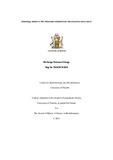| dc.description.abstract | Mycobacterium tuberculosis, the causative agent of the tuberculosis, has infected more than a
third of the world population to date. It has been known to be a very aggressive bacterium that is
highly resistant to current drugs that target Tuberculosis. Antibiotics such as viomycin and
capreomycin have been shown to bind to functionally important regions of the bacterial
ribosome inhibiting protein synthesis process thereby affecting the bacterial cells viability. It is
hypothesized that, a three dimensional structure of the 30S ribosomal subunit of the bacterium,
will bring about a novel approach on drug target, and will be important in the development of a
new class of anti-bacterial compounds. It will provide a structural scaffold on which structure
based drug design studies can be performed. In silico screening of ligands can be carried out to
identify compounds that show binding potential on ribosome, ribosomal RNA (16S rRNA) or the
ribosomal proteins. Since current methods for obtaining three dimensional structures of the
macromolecules are slow and tedious, we demonstrate a faster and inexpensive way of
generating structural models in silico by employing both de novo and homology modeling
methods
In this thesis, we report modeling of the three dimensional structure of the 30S ribosomal subunit
from Mycobacteria tuberculosis through the structure prediction methods mentioned above. We
report a high resolution ribosomal structure comparable in quality to experimentally determined
crystal structures. It is hypothesized that, the structure will bring about a novel approach on drug
target, and will be important in the development of a new class of anti-bacterial compounds. It
will provide a structural scaffold on which structure based drug design studies can be performed.
In silico screening of ligands can be carried out to identify compounds that show binding
potential on ribosome, ribosomal RNA (16S rRNA) or the ribosomal proteins. Compounds
identified this way can be further studied for antibacterial activity. We hypothesize that the
generation of the 30S ribosomal subunit from Mycobacteria Tuberculosis will provide a
structural scaffold that will allow In-silico structure based drug design. | en_US |


